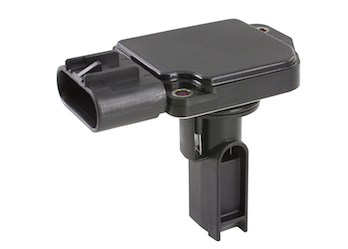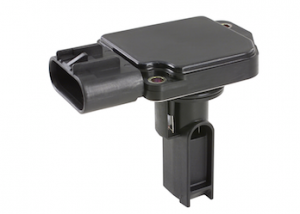One of the many things an engine management system has to know before it can accurately control the air/fuel mixture and spark timing is how much air is entering the engine. More air needs more fuel, as does more load on the engine and a wider throttle opening. The Throttle Position Sensor (TPS) can tell the PCM if the throttle is closed, part open or wide open, and the Manifold Absolute Pressure (MAP) sensor can measure intake vacuum as an indicator of engine load.
On fuel-injected engines with “speed-density” engine management systems, the Powertrain Control Module (PCM) can estimate airflow using these inputs, plus air temperature and engine RPM. But it’s not as precise as what can be achieved with a Mass Airflow (MAF) sensor. That’s why MAF sensors are used on a majority of late-model, fuel-injected engines.
Most fuel-injected engines use a Mass Airflow Sensor to obtain a more precise measurement of airflow. The MAF sensor is located in the tubing between the air filter housing and throttle. The sensor measures airflow with a heated element that is cooled by air flowing past the sensor. The amount of cooling the element experiences is directly proportional to airflow, so the PCM can get a very accurate reading on how much air is actually entering the engine. The sensor produces a digital frequency signal that changes with airflow.
Several things can upset the accuracy of the MAF sensor readings. Any air or vacuum leaks downstream of the sensor can allow “unmetered” air to enter the engine. This includes loose fittings or clamps in the plumbing between the air filter housing and throttle, as well as any vacuum leaks at the throttle body, intake manifold or vacuum hose connections to the engine.
Anything that contaminates the surface of the sensor also can screw up its ability to respond quickly and accurately to changes in airflow. This includes fuel varnish and dirt deposits as well as any debris that might get past of flake off the air filter itself. Some aftermarket “high-performance” air filters that use an open cotton weave filter element have been know to cause such problems.
A sluggish MAF sensor that is slow to react to changes in airflow can cause a variety of drivability and emission problems. The engine may start and stall or be hard to start, it may hesitate or stumble when accelerating or when the engine is under load, it may idle rough and get poor fuel economy.
Depending on the circumstances, the PCM may or may not detect the fault, turn on the Check Engine light and set one or more fuel mixture or sensor-related codes. So, the first step in diagnosing a suspected MAF problem is to hook up a scan tool to the vehicle and check for codes. The second step would be to look at the MAF sensor readings and fuel trim to see if the sensor is generating a good signal and that the engine management system is responding appropriately.
If a sensor has failed, there will be no signal. Sometimes the issue is in the sensor’s wiring circuit. A loose or corroded connector, broken or shorted wire may be causing a communication problem. That’s why its important to check the wiring circuit to make sure there are no problems there before replacing the sensor.
If the wiring checks out okay but the sensor seems to be under-reporting airflow or is sluggish, the sensor element is probably dirty and needs to be cleaned. Using an aerosol electronics cleaner or a product designed specifically to clean dirty MAF sensors will often restore normal operation and save your customer the expense of replacing the sensor. No other type of cleaner should be used to clean a MAF sensor because the wrong type of cleaner may contaminate or damage the sensor element.









